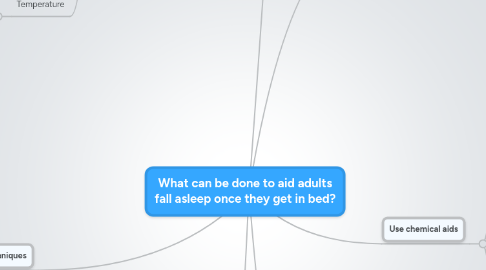
1. Practice relaxation techniques
1.1. Meditation
1.2. Breathing exercises
1.3. Mild physical exercise
1.4. Yoga
1.5. Leisure reading
1.6. Aromatherapy
1.7. Accupunture
1.8. Visualization
1.9. Hypnosis
1.10. Warm bath or shower
2. Create conducive physical environment
2.1. Bedding
2.1.1. Pillows
2.1.1.1. Too soft
2.1.1.2. Too hard
2.1.1.3. Self-adjusting
2.1.2. Mattress
2.1.2.1. Self-adjusting (firmness)
2.1.2.2. Temperature controlled
2.1.3. Sheets
2.1.3.1. Breathable materials/fabrics
2.1.3.2. Temperature adjusting
2.1.3.3. Clinginess factor
2.1.4. Tight-wrapping bedding like baby's blanket "taco" that induces sleep
2.1.5. Bed
2.1.5.1. Size
2.1.5.2. Shape
2.1.5.3. Position
2.2. Decor
2.2.1. No bright colors
2.2.2. No TVs or other electronics
2.2.3. Soothing color schemes
2.2.4. Limited, minimalist furniture
2.2.5. Remove clutter
2.3. Light
2.3.1. Curtains and window treatments to avoid light
2.3.2. Soft lightning
2.3.3. Dark chamber
2.4. Noise
2.4.1. White noise machine
2.4.2. Simulated lecturer looping sounds
2.4.3. "Elevator" music
2.4.4. Animal sounds
2.4.5. Earplugs
2.4.6. Noise cancellation system
2.5. Odors
2.5.1. Faint fruity aromas
2.5.2. Beach smells
2.5.3. Wild forest or mountain smells
2.5.4. Baked goods (cookies)
2.6. Temperature
2.6.1. Easy to control thermostats
2.6.2. Easy to close/open windows
2.6.3. Fans
3. Develop new sleep-inducing gadgets
3.1. Sleep-cap with neurological enhancement to help activate sleep in brain
3.2. Cocoon-like suit that recreates womb experience
3.3. Low-profile headphones with relaxation music/messages
3.4. REM-inducing lenses/Virtual Reality sleeping world
3.5. Soothing image projector (uses walls) with accompanying sounds
3.6. Aromatherapy + vaporized prescription drug dispenser
3.7. Portable sensory deprivation chamber
3.7.1. No light
3.7.2. No sounds
3.7.3. Neutral smells
3.7.4. Constant temperature
4. In bed but unable to fall asleep
4.1. Stress/Worries/Concerns
4.2. Discussions/Fights
4.3. Not tired
4.4. Too much food
4.5. Illness
4.6. Excitement
4.6.1. Good news
4.6.2. Bad news
4.6.3. Important event next day/ahead
4.7. Environment
4.7.1. Noise levels
4.7.2. Light levels
4.7.3. Bed/pillows/bedding
4.7.4. Room decor
4.7.5. Companions
4.7.5.1. Partner/Spouse
4.7.5.2. Children
4.7.6. Temperature
5. Use chemical aids
5.1. Prescription drugs
5.1.1. Sleeping aids
5.1.2. Drowsiness-inducing cold medicines
5.1.3. Opiates
5.1.4. Other narcotics
5.2. Non-prescription drugs
5.2.1. Herbal remedies
5.2.2. Natural extracts
5.2.3. Homeopathic remedies
5.3. Old-fashion
5.3.1. Warm milk
5.3.2. Teas
5.3.3. Carbos (cookies, etc.)
